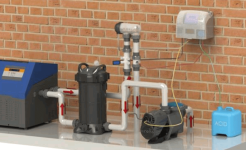Softener
My setup is near-identical to what Gene describes. My pool's auto-filler was plumbed to the landscape circuit, separate and before the indoor soft water circuit. I found a soft water line in the attic and ran it to where I needed, except I ran it down inside an exterior wall and then poked it out through the stucco (but Gene's MO is perfectly fine, too). I added a hose bib, for washing the car or solar panels. I added a proper backflow preventer. I left the original hard water source attached, and through a couple of valves I can choose hard or soft water (or mix them). I did this for a couple reasons, but primarily so that I could shut off my indoor circuit while away and still get water to the pool (though I've never used it because I don't travel much in the summer, I stay home and enjoy my pool).
I get that you don't want to dig up your yard. But for me, I did what I had to do and would again, even if it meant tearing out plants. Plants grow back, ruined plaster does not. The convenience alone was worth the trouble, and I had more than a little in the installation. I'm in my forever home, and the mods I describe in this post, while labor intensive, will provide benefits for the next several decades. That's how I look at it, anyway.
I bought a Whirlpool softener from Lowes. There are better ones, but mine had worked great. Not only did it solve my CH issue, but my whole house has thanked me! I also installed a Whirlpool whole-house water filter, and that has helped with the nasty water taste. I only drink water from the kitchen sink, which has an under-counter RO filter. I digress. My toilets look better. My shower glass. Lathering up is luxurious. I use less laundry soap. My shower heads and faucets look (and work!) like new, etc, etc.
Here's how I did it. This is in the middle of a very long thread, when I first came on board here, in which I was learning how to take care of my pool and deal with the hard water. But this is the section about adding the softener line:
#76.
IntellipH
Shortish version: The IntellipH (IpH) is a companion to the IntelliChlor (IC) and requires its presence. It uses the IC's temperature and flow sensors and uses its power supply. The IC plugs into the IpH, and the IpH then plugs into where the IC was plugged in. The IpH then controls the IC. That's why when the IC stops producing in the winter, so does the IpH.
Inside the IpH controller is a plastic connector that routes the power that was originally going directly to the IC through the IpH's circuit board. This connector is underrated, and sometimes cannot handle the current draw of the IC (especially the bigger IC60), and when the connector's pins start to get a little corroded, they build up heat and eventually melt the connector, severing the power to the IC and sometimes the IpH, too. I kid you not. Pentair has known about this issue for years, could easily fix it, but hasn't yet (as far as I know). They tell people not to use the IpH with an IC60, though we know for a fact that the problem sometimes happens with an IC40. Instead, they just replace the controller under warranty.
The fix is simple, and has been verified sound by many of us here. But it'll likely void your warranty. So I always recommend not doing anything during the warranty period. Let Pentair fix it. Then on day one past the warranty's expiration, apply the fix. It's basically just wire-nutting some wires together inside the controller. Easy. You can wait until it melts and then fix it, or you can apply the same fix ahead of time and avoid the melting problem altogether.
It's not a guarantee this problem will happen to you. It probably doesn't happen to most, which is why Pentair doesn't fix it I guess. So I don't want to scare you off from an IpH. I LOVE mine and wouldn't own a pool without it. But the problem
might occur, and you can fix it after it does, or before it happens. We have seen a few instances where the melt down fries the IpH circuit board, and then that requires a new board (not cheap). So if it were me, I'd apply the fix after the warranty expires and before it melts.
The other issue that I didn't like is losing the acid dispensing in the winter. So I devised a circuit that runs the IpH/IC combo normally in the summer, but bypasses the IC in the winter and allows the IpH to run year-round. It's not for the feint of heart, and will void your warranty for the IpH and your automation controller (if you have one). I waited until all my warranties expired, then installed the circuit. It's been working great. It's just some parts from Amazon and a soldering iron.
Whew, still with me? Some of us here have bypassed the IpH controller altogether and just run their IpH without it, using the scheduling circuits of their pool automation controller. That solves both the issues I describe above, but then you'd lose some of the great features (including great safety features) that Pentair devised for the IpH/IC combo. In terms of difficulty, this hack lies between the two I describe above. But if you're interested in any of these "fixes," we'll walk you through them step by step.
Here's a thread I wrote that you might find interesting. In addition to the winter wiring hack, it describes how I fixed my melted connector. That was before some others here came up with a much simpler method, which I describe at the end of this same thread:
As Pentair IntellipH (IpH) automatic acid dosing system owners know, the IpH depends on a Pentair IntellliChlor (IC) saltwater chlorine generator. The IpH uses the IC's power supply, and monitors its flow switch, so that it won't dispense acid if the IC is reporting low flow. Unfortunately, it...

www.troublefreepool.com
If you make it even part way through either of the threads I just gave you (or even this post!), you'll realize instantly just who you've been conversing with, and may choose to stop!

No hard feelings!



